P5140025
Cervical Spondylitis
Cenical spondylitis is an inflammation of one or morę vertebrae in the cervical region. It is gcnerally associated with degenerative joint disease and arthritis.
The Kinesio Taping Melhod will assist in the reduction ofedema, and pain.
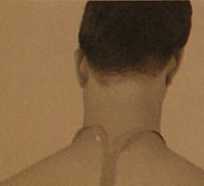
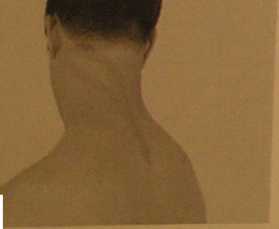
Basic Kinesio Taping Method application of [ muscie taping for the splenius capi tis and semispinJl lis capitis.
Begih by measuring the Kinesio Y strip from thoradc 3-5 to ocdput of the skuli.
Place the base of the Kinesio Y strip over the spinous process of T 3-5 with the neck in neutral position, and no tension on the base.
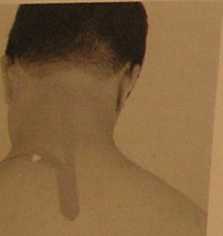
Have the patient move into neck flexion. Applyf| the medial taił along the spinous processes with ven Jight to light, 15-25 % of available, paper off tensiorlg from T 3-5 to C 5-6. Then begin to angle the taił towards mastoid process of the skuli along the hairif linę of the patient.
If the patients hair linę is Iow, be careful to not fl apply Kinesio Y strip taił onto the hair, this may 1 cause an increase in symptoms. If possible clip the | hair in this region. Inidate glue acdvadon prior to fl any further patient movement.
Have the patient move into neck flexion with i lateral rotation to the opposite side. Aiiń the lateralj taił towards the mastoid process with very light to ' light, 15-25 % of available, paper off tension. Initiatij glue activation prior to any further patient move- 1 ment.
This technique can be applied bilaterally, dependj ing upon the patients symptoms.

Application of the brachial plexus neurapraxia Kinesio Taping Method.
Measure a length of tape from just past the most distal point of paresthesia, to the ocdput of the skuli. Cut a Y in the proximal end to approximately the insertion point of the triceps muscle.
Tear the paper backing at the base of the Y cut and apply approximately a two inch area with no tension to the insertion point of the teres minor and major.
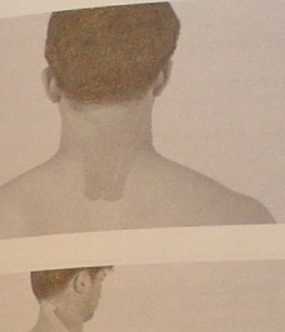

Have the patient move into shoulder f!exion with horizontal flexion and neck rotation with lateral flexion to the opposite side of the injury.
Apply the upper taił along the upper trapezius to the occiput of the skuli. The lower taił is placed either over any detectable trigger point or along the teres minor and major to approximately the axillary border of the scapula.
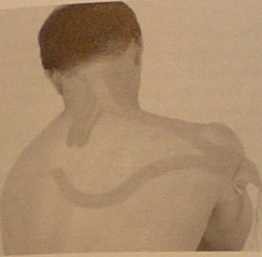
Ha ve the patient flex their wrist and elbow and while maintaining shoulder flexion. Apply the Kinesio Strip with very light to light, 15-25 % of available, paper off tension along the paraesthesia.
At the elbow wither adjust the Kinesio Strip to miss the olecranon process, to avoid placing pressure over the olecranon bursa, or cut a hole in the middle of the Kinesio Strip directly over the olecranon process.
Continue over the dorsum of the forearm and to the dorsum of the hand.
The brachial plexus nerve strip only needs to be applied as far down the arm as the radiating pain is felt by the patient.

Completed application of the Kinesio Taping Method for cervical spondylitis.
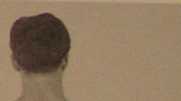

Wyszukiwarka
Podobne podstrony:
08vcl02 C++ program if [relation is true]{ Body of one or ◄- morę C++ statements} 7/ Rest of program
08vcl03 C++ program If [relation is true]{ Executes only if relation is true Body of one or ◄- morę
CSG236 Unit 19Personal Pronouns A pronoun is used in place of one or morę nouns or another word that
P5140109 Sever s Syndrome or Apophysitis of the Calcaneus Scver s syndrome is an inflammation of the
P5140120 Plantar Fasciitis Plantar Fasciitis is an inflammation of the plantar aponeurosis. Pain and
Selecting Particular Rows As shown in the preceding section, it is easy to retrieve an entire table.
50 (142) 50 • THE PATTERN COLLECTIONCrescent Collar This is an example of random or irregular tattin
563 BYZANTINE INFLUENCE IN THE BALTIC REGION? and pnppi, priest , from Old Russian popu. Is this an
563 BYZANTINE INFLUENCE IN THE BALTIC REGION? and pnppi, priest , from Old Russian popu. Is this an
563 BYZANTINE INFLUENCE IN THE BALTIC REGION? and pnppi, priest , from Old Russian popu. Is this an
The sideband whtch remains is then amplified by one or morę stages of linear amplification to i
więcej podobnych podstron